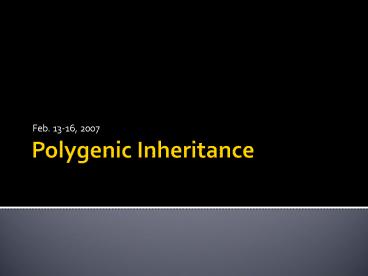Polygenic Inheritance - PowerPoint PPT Presentation
1 / 16
Title:
Polygenic Inheritance
Description:
contributing or additive alleles. non-contributing or non-additive alleles ... 1 contributing allele. 2 contributing alleles. 3 contributing alleles. 4 ... – PowerPoint PPT presentation
Number of Views:967
Avg rating:3.0/5.0
Title: Polygenic Inheritance
1
Polygenic Inheritance
- Feb. 13-16, 2007
2
Grab your fly vials
- Need to clear P1 parents from Drosophila cultures
- prevents P1 flies from mating with F1 flies that
will be hatching in a few days - Take vials outside, release stopper, and make
sure all adult flies are out of the vial - replace stopper and return vial to the front
counter
3
Polygenic Inheritance
- more than 1 gene pair influences trait
- polygenes
- contributing or additive alleles
- non-contributing or non-additive alleles
- Many traits show continuous variation
- i.e., human height, IQ
- Traits also influenced by environment
4
Continuous vs. Discrete
- Polygenic traits may show continuous or discrete
phenotypes - Usually related to number of alleles involved
- May also be affected by environmental factors
5
Example
- 4 gene pairs influence rabbit ear length
- each allele contributes equally
- AABBCCDD will be longest
- aabbccdd will be shortest
6
Example
- Pure-breeding homozygote with 8cm ears (AABBCCDD)
mated to pure-breeding homozygote with 4 cm ears
(aabbccdd) - F1 generation uniform, 6cm ears (AaBbCcDb)
- F2 has continuum of ears 4-8cm, with most between
5-7cm
7
Estimating number of gene pairs
- Estimated from fraction of F2 with phenotype
expressed by P1 ancestor - Estimated through binomial expansion
(p q)n
8
Generating Expected Fractions
ps exponent x coefficient number in series
- Use Pascals triangle
- Expand the binomial
- (p q)n where n is number of alleles
9
Pascals triangle
1
(p q)0
(p q)1
1
1
(p q)2
2
1
1
(p q)3
3
3
1
1
(p q)4
4
6
1
1
4
(p q)5
5
10
1
5
1
10
(p q)6
6
15
1
15
6
20
1
7
21
1
35
21
35
1
7
(p q)7
(p q)8
8
28
1
70
56
56
8
28
1
(p q)9
9
36
1
126
126
84
36
84
9
1
10
45
1
210
252
120
120
210
45
10
1
(p q)10
10
Binomial expansion
- Lets expand the binomial (pq)6 and calculate
the expected fraction for 6 alleles (3 pairs)
p6 6 p5q 15 p4q2 20 p3q3 15 p2q4 6 pq5
q6
11
Binomial expansion
- Lets expand the binomial (pq)6 and calculate
the expected fraction for 6 alleles (3 pairs) - Add coefficients
- 161520156164
- Expected fraction is 1/64
p6 6 p5q 15 p4q2 20 p3q3 15 p2q4 6 pq5
q6
12
Calculating Expected Fractions
1
(p q)0
(p q)1
1 contributing allele
2 contributing alleles
1
1
0 contributing alleles
AA
Aa
aa
(p q)2
2
1
1
2 polygenes (1 pair)
(p q)3
3
3
1
1
(p q)4
4
6
1
1
4
4 polygenes (2 pair)
0 contributing alleles
2 contributing alleles
4 contributing alleles
1 contributing allele
3 contributing alleles
13
Estimating Number of Gene Pairs
- How many offspring of an F2 cross resemble the
original parent? - Obtained through ratio of coefficients obtained
from expansion of the binomial - 4 genes (2 pair) 1/16
- 6 genes (3 pair) 1/64
- 8 genes (4 pair) 1/256
- 10 genes (5 pairs) 1/1024
- 12 genes (6 pairs) 1/4096 (1/212)
- Hintnotice the expected fraction decreases by
the reciprocal of 2 raised to the power of the
number of genes
14
Two gene pairs
- (¼)2 1/16
- 1/16 will be AABB
- 1/16 will be aabb
15
Estimating Allele Contribution
- Find the number of gene pairs involved
- Find the amount that all gene pairs add
- Distribute that amount over the number of gene
pairs
16
Number of Gene Pairs
- average most extreme phenotypes
- (9 4)/2 6.5
- determine the fraction of these offspring present
- 6.5/1776 0.0037
- find n of (¼)n
- (¼)n 0.0037
- n 4 pairs

